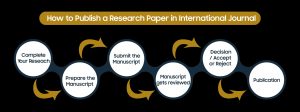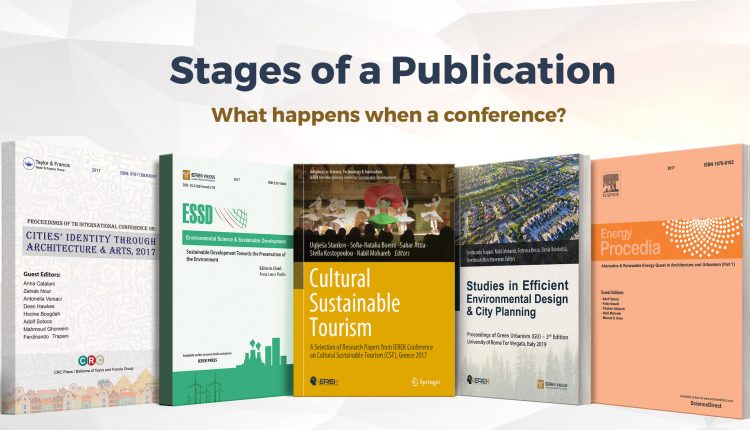Stages of a Publication & Internal Operations
What happens when a conference ends and how is the publishing process carried out?
“It’s not only what happens at the conference
–but also, what happens after”
In IEREK’s August 2021 newsletter, an internal scoop by the organizers themselves gave insight into the stages and efforts exerted in the organization of an international scientific conference. In this blog, we expand further on what goes on after the conference and most importantly, how the publishing process is carried out.
Setting the Scene
After the closing ceremony is held, authors contributing with their research and ideas through their submissions begin wondering about the publishing process and looking to the organizers and committee for answers. That being said, it is safe to say that not everything of value happens just at the conference, but a lot of what happens on site greatly affects the work done after it. In receiving a set of proceedings (a book of abstracts or book of papers) that is meant to inform the participant of other research conducted and latest trends in the field, the researcher or ‘reader’ is given the opportunity to explore and benefit from further research. Combined with the feedback provided by session moderators on a delivered presentation and discussions stimulated, a conference provides researchers with room for further improvement when it comes to their submitted work.

What Happens After an IEREK Conference?
Once a submitted research paper is preliminarily reviewed and accepted for presentation at the conference, IEREK’s publishing department set out to prepare it for consideration in a predetermined journal or book.
Regardless of where a manuscript is published in the end, it must be thoroughly and rigorously assessed by a panel of reviewers, or experts in the field, who provide their written and unbiased feedback. This is known as the Peer Review Process, which is defined as a system used to assess the quality of a manuscript before it is published. This system can vary slightly between journals and books. Yes, books!
The process, also known as an Editorial Process, is also an integral component to academic book publishing that ensures a high level of academic quality is maintained.

Understanding the Peer Review Process
Types of Peer Review
There are four main types of peer review used by journals: Single-Blind, Double-Blind, Open Peer and Transparent Peer. IEREK undertakes the double-blind peer review process in most of its publications where reviewers do not know the names of the authors and the authors do not know the names of the reviewers. By maintaining anonymity, the Editors and Journal ensure that bias is eliminated from the process.
Peer Review Process for a Journal
When a manuscript is submitted to a journal or a conference and meets the requested criteria (preliminary review), which includes but is not limited to an assessment of its composition, stylizations and structure against the author’s guidelines provided prior to the conference. Afterwards, it is sent for appraisal by the editor-in-chief of the journal.
The editor-in-chief is responsible for checking the appropriateness of the paper, its originality and significance or its contribution to the field. If no major issues, in checking its scientific quality, are detected, the paper proceeds to the peer review process. Some journals have associate editors who set the peer review process in motion as the next stage.
Once an editor or set of editors are assigned a paper or more, they are responsible for sending invitations to experts in the field he or she believe would be appropriate for the review. A form to guide the review is shared by some journals. A minimum of 2 reviewers are required for the review and, if necessary, may increase where there is conflict or a need for further input. In inviting reviewers to assess submitted papers, the editor looks out for any potential conflicts of interest to ensure the process is fair. In which case, other reviewers are allocated as substitutes.
The reviewers are given a timeframe, during which they set time aside to read the paper carefully and provide detailed comments where needed before recommending a decision. Their review is submitted to the journal accordingly. If 2 out of 3 reviewers, accept the work as it is or with further comments to be addressed, the paper is considered for publication. The editor is responsible for handling all returned reviews before making a final decision – be it rejection, acceptance, or acceptance with notes – based on the feedback and recommendations made. If the reviews differ widely, the editor may invite one or more additional reviewers.
Once a final decision is made, the editor communicates his or her final decision to the author(s) of the submitted paper. The anonymity of the comments made depend solely on the type of peer review used by the journal and discussed in the below section.
The final steps are for the authors to address reviewer and editor comments, if any, only in the case that the work is accepted with comments. After modifying their work, they are expected to send their modified work back to the editor for another round of evaluation. Once approved, the authors are informed and then the work is sent to production. If the work is rejected, the author is notified by email and a rejection email and letter are communicated with constructive comments shared to help the author improve the article in the future. If the work is approved without any comments to be addressed, the work is directly moved along to the production process.

Peer Review Process for a Book
The peer review process for a book highly resembles that of a scientific journal in the sense that editors recruited for a volume are responsible for allocating reviewers (a) from their own connections or by (b) establishing new connections. Editors are also responsible for ensuring that the reviews conducted are detailed, constructive and informative. They are responsible for communicating these comments, along with their final decisions to the authors or moderators (such as IEREK Editors) responsible for sending through the relevant documents, due dates and decision letters. It is a back and forth process, similar to that of a journal, with differences in the stages undertaken. To know more about the peer review process for books in the ASTI series, stay tuned and read up on the ‘ASTI Series Peer Review’ blog!
To summarize, a peer review is the most significant part of scientific publishing as it allows the work to become more robust, easier to read and more useful. In pointing out gaps and issues with the paper, it allows it to become more credible and useful to other researchers looking to benefit from it as well as build on it.
Once the peer review process of a publication is completed successfully, the production department is responsible for printing, binding, and arranging it for its delivery to the publisher’s warehouse or online publication and appearance.
One of the most essential stages in a publication’s lifecycle is the indexation, archiving and attempts at increasing the work’s citations. For more information and what you should do as an author after your work is published, read our published blog on ‘How to Increase Your Citations’.


